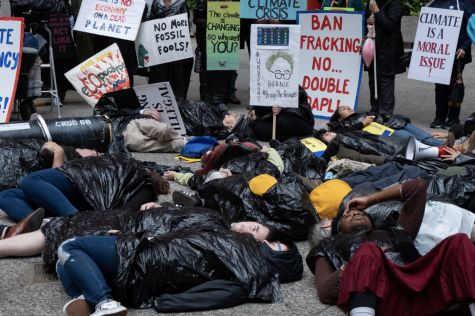Illinois residents protest doubling of the Dakota Access Pipeline
September 28, 2019

Strikers wore black and laid on the ground to portray oil leaking from The Dakota Access Pipeline at a Sept. 27 protest.
The heavy rain on Friday did not stop Chicagoans from demanding Gov. J.B. Pritzker declare a climate emergency in Illinois, ban fracking and halt the doubling in volume of the Dakota Access Pipeline.
The organization Save Our Illinois Land, along with Indigenous Environmental Network, National Nurses United, Sierra Club and Extinction Rebellion Chicago, among others, held a rally Friday, Sep. 27, to protest the pipeline’s expansion and called for the governor to take strides in addressing the climate crisis. Protesters gathered at Federal Plaza before marching to the Thompson Center.
Although the pipeline has been controversial from the start, Friday’s protest was spurred on by a June 12 request to the U.S. Army Corps of Engineers from Energy Transfer, the company behind the oil pipeline, to increase the capacity of its pipeline by doubling the volume from its original 570,000 barrels of crude oil per day to 1.1 million.
The company’s proposal, which is still pending, would install additional oil pumping stations on existing pipelines in the state, as reported Sept. 27 by WBBM-780.
Charlie Ryan, the event coordinator and volunteer with Save Our Illinois Land, said doubling the capacity of the pipeline would pose a threat to many residents. The pipeline carries crude oil from North Dakota, through South Dakota, diagonally through 18 counties in Iowa, and ends in Illinois, according to the Sierra Club.
“One of the farmers in Illinois is worried, he’s within about a half a mile of the pumping station, and he’s worried [about] what happens when they have a break,” Ryan said. “They have these tiles that fill up with oil because the oil gravitates to those. And then it disseminates underground and destroys their productivity.”
The Dakota Access Pipeline was first proposed in 2014 and, since then, it has stirred conflict with various groups. The original proposal was for a 1,134-mile underground pipeline to transport crude oil from North Dakota to Patoka, Illinois, which is about four hours from Chicago. One of the biggest conflicts of the pipeline route was with the Native American tribe Standing Rock Sioux.
The pipeline was constructed under Lake Oahe, the main water supply for the 8,250 people on the Standing Rock Reservation, which straddles the border between North Dakota and South Dakota. Although oil pipelines are considered a safer transportation method than rail, they still pose a potential threat of oil spills contaminating water, critics argue. The route also went through sacred sites outside the Standing Rock Reservation.
In 2016, the protests peaked as Standing Rock Sioux sued the U.S. Army Corps of Engineers for failing to consult with the tribe, a requirement of “tribal sovereignty.” The situation further intensified when police used pepper spray and water cannons in below-zero temperatures against protesters, leaving 16 people arrested and hospitalizing 26 of more than 300 protestors, as reported Nov. 21, 2016, by The Guardian.
In 2017, the U.S. Court of Appeals for the District of Columbia Circuit rejected Standing Rock Sioux’s request to halt the oil flowing through their community.
Since the Dakota Access pipeline began operating in 2017, it has had at least 10 oil spills, according to InsideClimate News.
“We’re here because we’re still fighting the same pipeline system,” said Dallas Goldtooth, a leader in the Indigenous Environmental Network. “We do it because we have no choice, because we know that this current life, this current economic system is predicated upon the death of so many people and places that we don’t see. … This economic system is killing this planet.”








